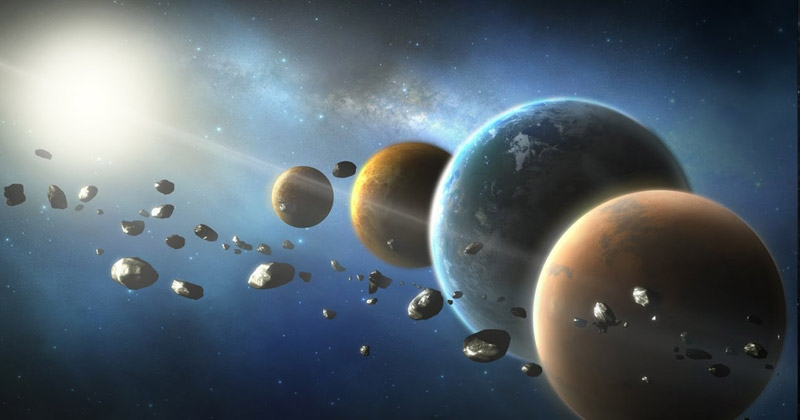Astronomers have recently discovered that Jupiter is the oldest planet in our solar system. Even in size, it dominates all its neighbors. But as more and more planets outside our solar system, called exoplanets, are discovered, Jupiter seems to be losing its prominent position.
Here are the six current planet record holders in the universe.
The Largest Planet

Jupiter is 2.5 times as heavy as all other planets in the solar system and a whopping 320 times as heavy as the earth. But in the vastness of space, there are much larger planets, for example – DENIS-P J082303.1-491201 b, is a huge gas planet and nearly 30 times heavier than Jupiter. It is controversial whether it is a planet or a weak star called a brown dwarf. This star type is not massive enough to fuse hydrogen in its interior to helium (as our Sun and all other stars do). However, in brown dwarfs, other fusion reactions happen at lower temperatures. Till it is finally clarified, DENIS-P J082303.1-491201 b is the largest planet yet discovered. It is the best example of the most extreme planets in space.
The Smallest Planet

With even today’s technical capabilities, finding tiny planets outside our solar system is not easy. Nevertheless, NASA astronomers succeeded in doing so in 2013 with the Kepler Space Telescope. 210 light-years from Earth they found Kepler-37 b, a true little thing. He is smaller than Mercury and only slightly larger than the Moon. Most likely, the planet has a solid surface. Its two brother planets Kepler-37c and -37d are similar in size to the earth, the mother star is also very similar to the sun. However, this planetary system differs enormously from ours. All three planets orbit their home star in a very narrow radius. Kepler-37 b needs just 16 days for one round. Its surfaces are so hot that life is unthinkable.
The Oldest Planet

Our Earth has already created a lot of things in the 4.5 billion years since its creation. It has given birth to life that evolved into an intelligent species. But compared to a certain exoplanets, the earth is just a teenager. The planet PSR B1620-26 b is located in a distant star cluster about 12,400 light-years away, is unbelievably 13 billion years the oldest known planet. It emerged shortly after the big bang and survived the two stars it Orbits around. It is also the first confirmed circumbinary planet which means it orbits around two stars. PSR B1620-26 b orbits around stars out of which one is a white dwarf, the other a neutron star, both the barren remains of once mighty fireballs. It is certainly one of the most extreme planets in space as it has outlived two different stars.
The Youngest Planet

There are planets that are almost childlike on an astronomical scale. This includes the planet V830 Tauri b orbiting a star that is barely two million years old. At the time of its birth, our ancestors have already used the first stone tools. But something like stone tools will not exist on V830 Tauri b even in the distant future. It is a planet that presumably has no solid surface and consists only of gas. In addition, it is so close to his star that it is unbearably hot for life. Due to its size, V830 Tauri b is also called “Hot Jupiter”.
The Hottest Planet

In our solar system, the rule of thumb is that nothing is hotter than the sun. The temperature on their surface is unimaginable 5500 degrees Celsius. One of the hottest planets in our solar system, Mercury, is also the closest to the Sun. Its surface temperature rises up to 430 degrees Celsius a day. Hot enough to melt lead. Only on Venus, a little further from the Sun than Mercury, gets even hotter due to a strong greenhouse effect, that is up to 500 degrees Celsius.
One of the most extreme planets in space in terms of temperature is KELT-9 b, a huge gas planet, about 620 light-years away from Earth. During the day, the temperature reaches up to 4327 degrees Celsius. It is because KELT-9 b is very close to its star, even closer than Mercury to the sun. In addition, the star that KELT-9 b Orbits around releases a lot of energy and is almost twice as hot as the sun at around 10,000 degrees Celsius. KELT-9 b’s atmosphere is so heated that it no longer contains molecules such as water or carbon dioxide, but only individual, ionized atoms. These swirl around chaotically, similar to a star. Researchers therefore call it a ‘hybrid planet’ – ‘outside star, inside planet’.
The Coldest Planet

If a star is low in energy, it looks bleak for its planet as in the case of the planet OGLE-2005-BLG-390L b which is about 20,000 light-years from Earth. Its home star is a red dwarf, the smallest and coldest form of stars. Moreover, as the planet orbits it at a relatively large distance of approximately between the orbits of Mars and Jupiter in our planetary system. The surface of OGLE-2005-BLG-390L b extremely frosty. OGLE-2005-BLG-390L b is indeed a rock planet like Earth and only five times as heavy. But at temperatures of minus 220 degrees Celsius, just about 50 degrees above absolute zero, there is little chance of life on one of the most extreme planets in space. Gases like oxygen and nitrogen are already frozen to ice and snow under such conditions.
Life on most of these planets seems impossible because of the extreme conditions planetwide. However, there is no doubt that these are the most extreme planets in space as they have changed our perspective of looking at planets as just a ball of stardust.


